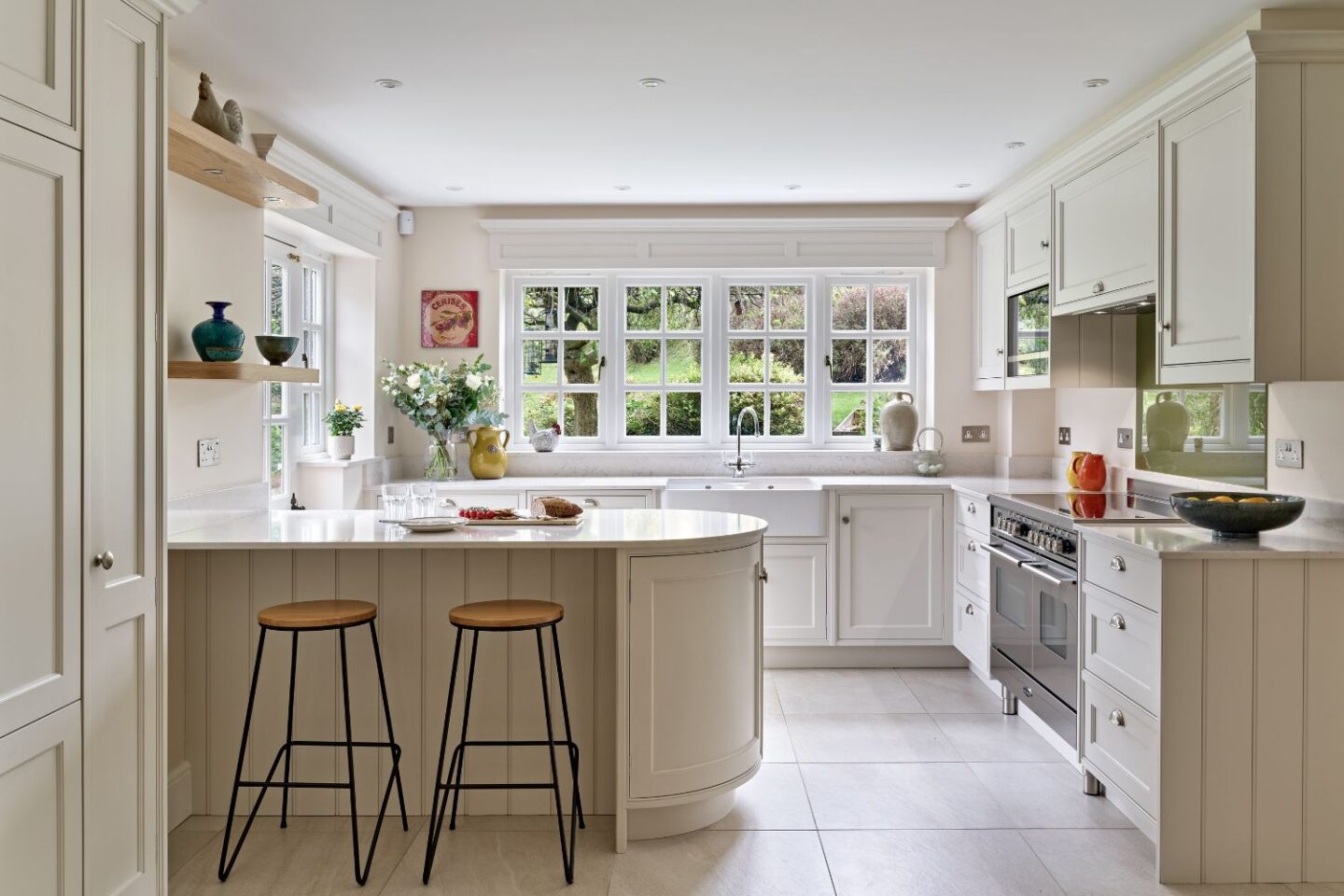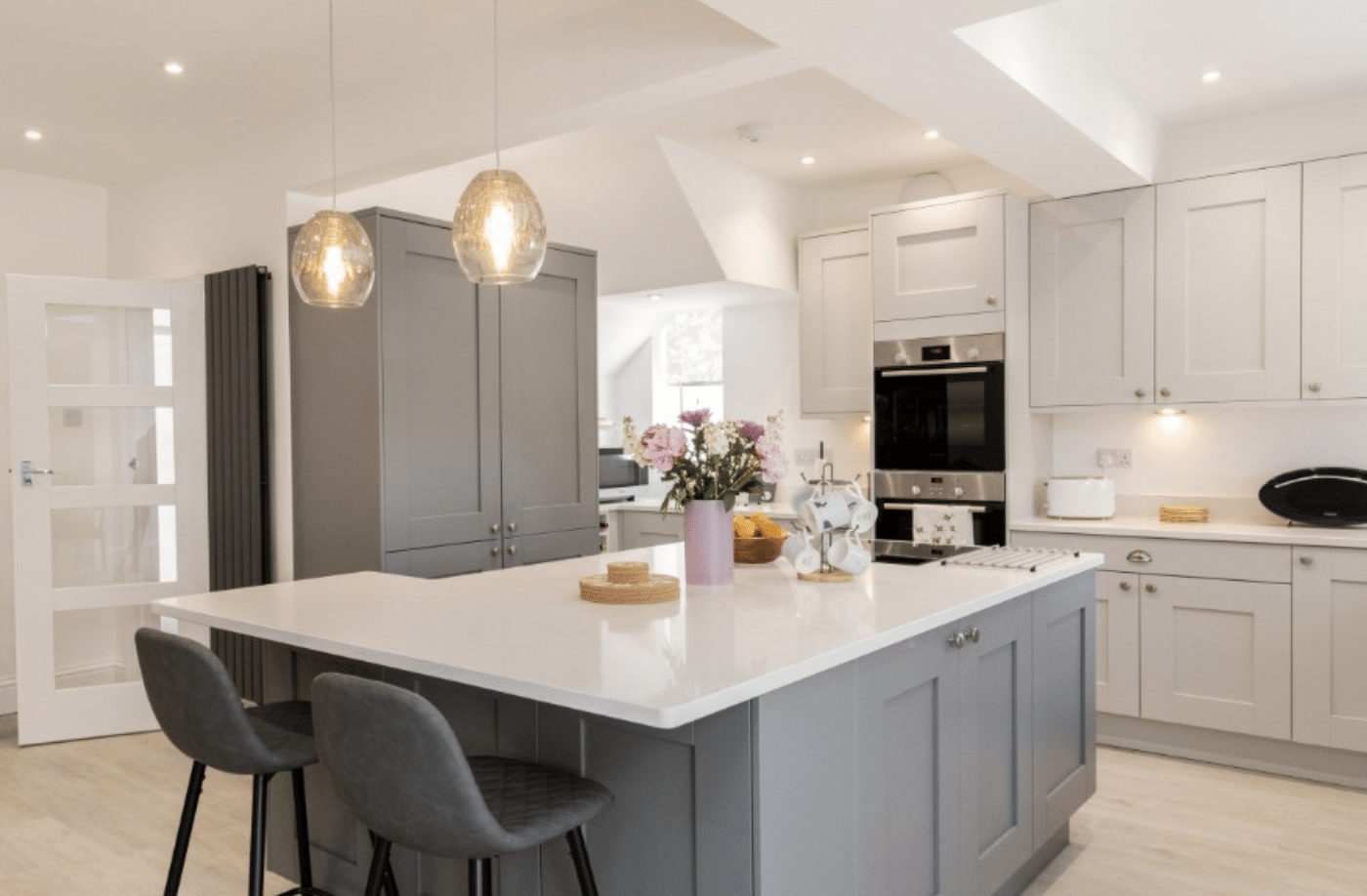
If you’ve ever stepped into a new build home, you’ve probably noticed one thing, downlights. Lots of them.
It’s part of the property developers starter pack which also includes bright white paint and bull nose skirting, often used throughout every room as a ‘one size fits all solution’. Whilst it can be argued that downlights are a sleek and modern form of lighting, they were never designed to light an entire home.
I learnt so much about creating an effective lighting plan for a home after working for a lighting company for a number of years, and I’ve also brought in the experts to dispel the myths on downlights, and how you should really be using them in your home.
The Problem With Using Downlights Everywhere
There is a definite time and place for downlights in an interior, but the whole house isn’t one of them.
The reason that many developers install these in new builds everywhere has nothing to do with style, they’re cheap to install and easy (a standard GU10 downlight can set you back at around £10.57 pre trade price). Because downlights act as a form of task lighting, they become redundant in most rooms of the home.
If they’re used throughout an interior, the result is a flat and often clinical lighting scheme which can cause glare. You can expect no ambience or warmth in an interior when using a singular lighting source.
Whilst downlights can be installed on dimmer switches for flexibility, this isn’t the answer for the rooms that really don’t need them.
Adam Bushell, Director of AB Electrical & Communications, specialises in residential & commercial electrical work and has seen firsthand how the overuse of downlights can often lead to functional and aesthetic issues in a space.
Adam said, “Downlights have their place especially in areas that need focused lighting or a sleek and modern look. However, using them in every room can create problems with the overall ambience and energy efficiency of a home”.
“Another concern is the energy consumption and maintenance that comes with excessive downlight use. They tend to consume more power compared to other lighting options”.
“They are often built into the ceiling and can be harder to replace when necessary. Combining downlights with other lighting options helps maximise your space while maintaining both comfort and functionality”.

When Downlights Do Work
Downlights are a form of task lighting, this means that they are designed for use in rooms for preparation of tasks, or spaces that need a more direct form of lighting. Depending on the type of downlight you purchase, you can also buy ones that can be angled so you can direct the flow of light where you really need it.
One room that should always include downlights is a kitchen for task preparation. They still don’t need to be used as the singular light source in a kitchen, but effectively placed around kitchen worktops to aid your tasks with ease. Roughly downlights should be placed 60cm away from cabinetry to avoid shadows being cast, but if you don’t have any upper cabinetry, then they may work better in line with the end of your worktop.
Office spaces and bathrooms are two other rooms that may also benefit from the correct placement of downlights, however, this totally depends on the space, and how the room is used. A set of well placed wall lights on either side of a mirror is a much more effective source of task lighting than downlights as they help to gently diffuse the light across your face.
The only other exception is rooms with eaves or those with very low ceiling height, however, you can still add more of a design aspect with flush mounted lights that pack both light and style.
Adam added, “relying solely on downlights can make the space feel cold and uninviting, as the light tends to be more direct and harsh. In contrast, softer and ambient lighting like wall sconces or table lamps can create a warmer and more comfortable atmosphere”.
As Adam mentions, a layered lighting scheme involves using multiple light sources to create an ambient scheme. This typically includes pendant lighting, downlights (if the room requires it), table lamps, floor lamps and wall lights. A layered scheme means the lighting can be completely custom to the room as the role changes throughout the day.

How To Fix A Lighting Plan That Relies on Downlights
If you’ve just moved into a property dominated by downlights, don’t panic. Without costly electrical work, you can still create a structured lighting plan to work around the downlights, giving you some sense of ambience and warmth in the interior.
There are now some really affordable ways to add wall lights to your home without the need for electrical work. Rechargable wall lights mean you can instantly add light and warmth to your darkest corners, or bring ambience to places that desperately need it, such as to light a long hallway, or to add to either side of a mirror in a bathroom.
You can then consider adding other forms of lighting such as table lamps and floor lamps, there’s never been a truer statement that ‘who even uses the big light anyway?’ when it comes to downlights, when it’s 9pm at night no-one wants to be met by the intensity of downlights on full beam.
Introducing these options will add some softness to different surfaces that need it. It’s one I will also mention, but many overlook ‘kinetic lighting’ this is things such as candles, they’ll add a warm, sympathetic glow of any evening and are a fail safe way to add instant ambience throughout an interior.
Bonus tip: you can easily change the bezels of your downlights, this is the metal ring surrounding the downlight. I always recommend opting for white bezels or even better, paintable bezels so they perfectly blend in with your decor. Opting for metal finishes may work with your hardware, but it ends up drawing too much attention to the ceiling as it ends up segmenting the ceiling.

Key summary of using downlights in an interior;
- They are not a one-size-one-room fits all type of lighting
- Designed for task lighting only in rooms that require it, such as kitchens to aid food preparation
- Downlights can still be used effectively, when part of a larger layered lighting scheme
- Always opt for white bezels or paintable bezels (if you have a bold ceiling) so they blend into your decor, rather than segmenting the ceiling
The below kitchen is a perfect example of how a lighting plan should flow in a kitchen, downlights are used roughly 60cm away from the edge of upper cabinetry to avoid any shadows being cast, creating direct lighting where it’s required, with pendant lights over the kitchen island for an ambient glow.
If you have any other questions regarding using them in your lighting scheme, please leave me a comment below and I’ll come straight back!

